Peugeot Boxer 2016 User Guide
Manufacturer: PEUGEOT, Model Year: 2016, Model line: Boxer, Model: Peugeot Boxer 2016Pages: 292, PDF Size: 10.07 MB
Page 11 of 292
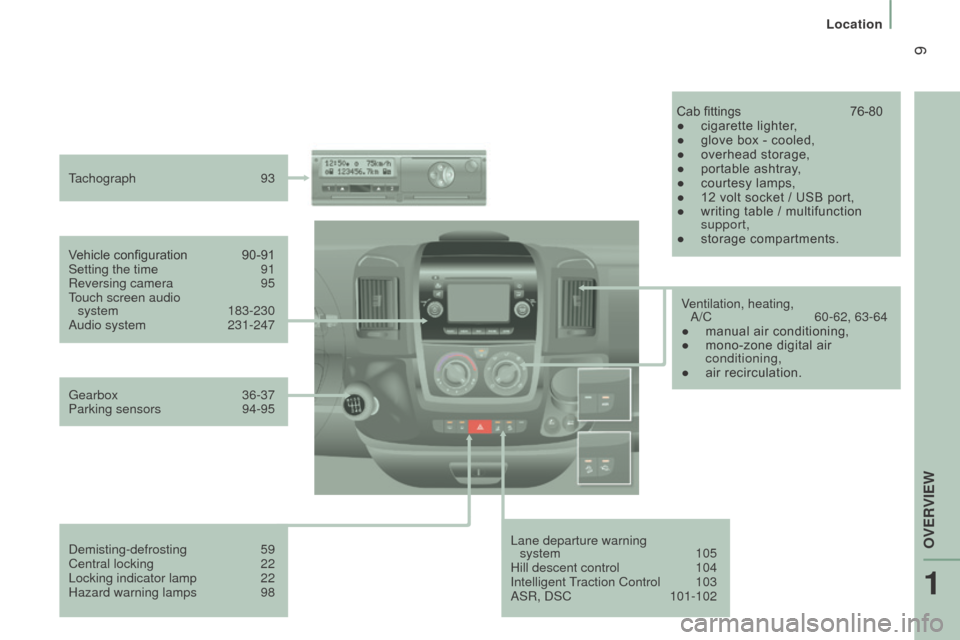
9
boxer_en_Chap01_Vue-ensemble_ed01-2015
Lane departure warning system 105
Hill descent control
104
Intelligent
t
raction
Control
103
ASR, DSC
101-102
V
ehicle configuration
90-91
Setting the time
91
Reversing camera
95touch screen audio
system
183-230
Audio system
231-247
tachograph
93
Cab fittings
76-80
●
cigarette lighter
,
●
glove box - cooled,
●
overhead storage,
●
portable ashtray
,
●
courtesy lamps,
●
12 volt socket / USB port,
●
writing table / multifunction
support,
●
storage compartments.
g
earbox
36-37
Parking sensors
94-95
Demisting-defrosting
59
Central locking
22
Locking indicator lamp
22
Hazard warning lamps
98 V
entilation, heating,
A/C
60-62, 63-64
●
manual air conditioning,
●
mono-zone digital air
conditioning,
●
air recirculation.
1
OVeRVIeW
Location
Page 12 of 292
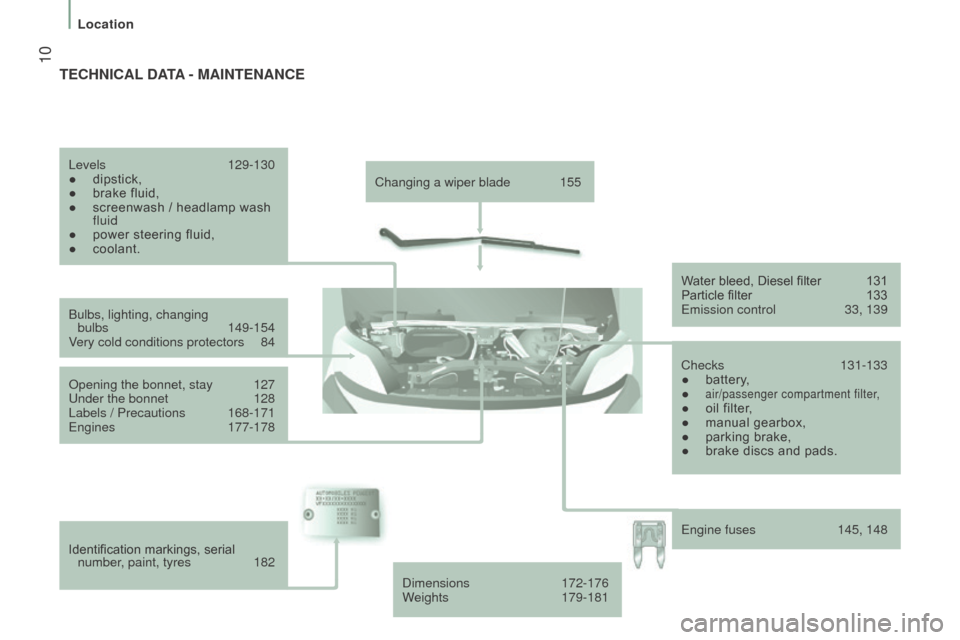
10
boxer_en_Chap01_Vue-ensemble_ed01-2015
Changing a wiper blade 155
Bulbs, lighting, changing bulbs
149-154
Very cold conditions protectors
84
Opening the bonnet, stay
127u
nder the bonnet
128
Labels / Precautions
168-171e
ngines
177-178
Identification markings, serial number, paint, tyres
182
Levels
129-130
●
dipstick,
●
brake fluid,
●
screenwash / headlamp wash
fluid
●
power steering fluid,
●
coolant. W
ater bleed, Diesel filter
131
Particle filter
133e
mission control
33, 139
Checks
131-133
●
battery
,
●
air/passenger compartment filter,● oil filter,
● manual gearbox,
●
parking brake,
●
brake discs and pads.
tEcHnIcAL d AtA - M AI nt E n A nc E
Dimensions 172-176
W eights 179-181
e
ngine fuses
145, 148
Location
Page 13 of 292
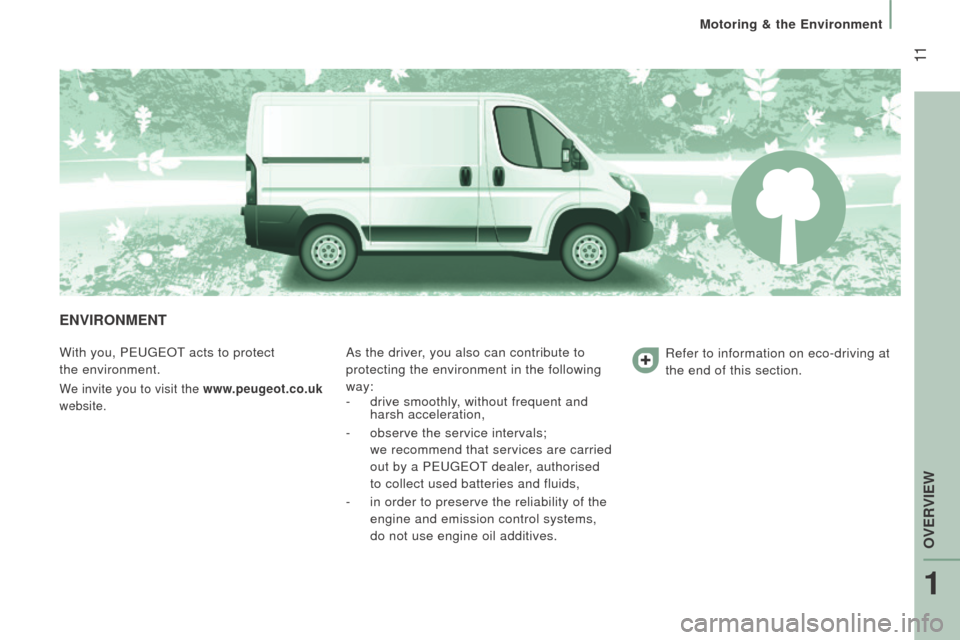
11
boxer_en_Chap01_Vue-ensemble_ed01-2015
EnVIronMEnt
With you, PeugeOt acts to protect
the environment.
We invite you to visit the www.peugeot.co.uk
website.
As the driver, you also can contribute to
protecting the environment in the following
way:
-
drive smoothly
, without frequent and
harsh acceleration,
-
observe the service intervals;
we
recommend that services are carried
out by a P
euge O t
dealer
, authorised
to collect used batteries and fluids,
-
in order to preserve the reliability of the
engine and emission control systems,
do not use engine oil additives. Refer to information on eco-driving at
the end of this section.
1
OVeRVIeW
Motoring & the environment
Page 14 of 292
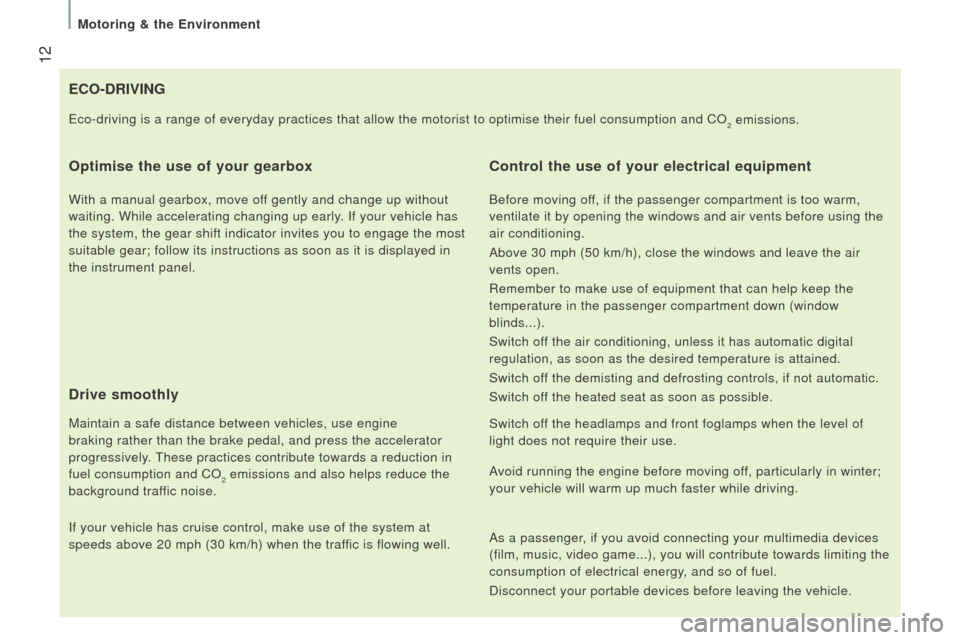
12
boxer_en_Chap01_Vue-ensemble_ed01-2015
Eco-drIVInG
o ptimise the use of your gearbox
With a manual gearbox, move off gently and change up without
waiting. While accelerating changing up early. If your vehicle has
the system, the gear shift indicator invites you to engage the most
suitable gear; follow its instructions as soon as it is displayed in
the instrument panel.
drive smoothly
Maintain a safe distance between vehicles, use engine
braking rather than the brake pedal, and press the accelerator
progressively.
t
hese practices contribute towards a reduction in
fuel consumption and CO
2 emissions and also helps reduce the
background traffic noise.
If your vehicle has cruise control, make use of the system at
speeds above 20 mph (30 km/h) when the traffic is flowing well.
control the use of your electrical equipment
Before moving off, if the passenger compartment is too warm,
ventilate it by opening the windows and air vents before using the
air conditioning.
Above 30 mph (50 km/h), close the windows and leave the air
vents open.
Remember to make use of equipment that can help keep the
temperature in the passenger compartment down (window
blinds...).
Switch off the air conditioning, unless it has automatic digital
regulation, as soon as the desired temperature is attained.
Switch off the demisting and defrosting controls, if not automatic.
Switch off the heated seat as soon as possible.
Switch off the headlamps and front foglamps when the level of
light does not require their use.
e
co-driving is a range of everyday practices that allow the motorist to o\
ptimise their fuel consumption and CO
2 emissions.
Avoid running the engine before moving off, particularly in winter;
your vehicle will warm up much faster while driving.
As a passenger, if you avoid connecting your multimedia devices
(film, music, video game...), you will contribute towards limiting the\
consumption of electrical energy, and so of fuel.
Disconnect your portable devices before leaving the vehicle.
Motoring & the environment
Page 15 of 292
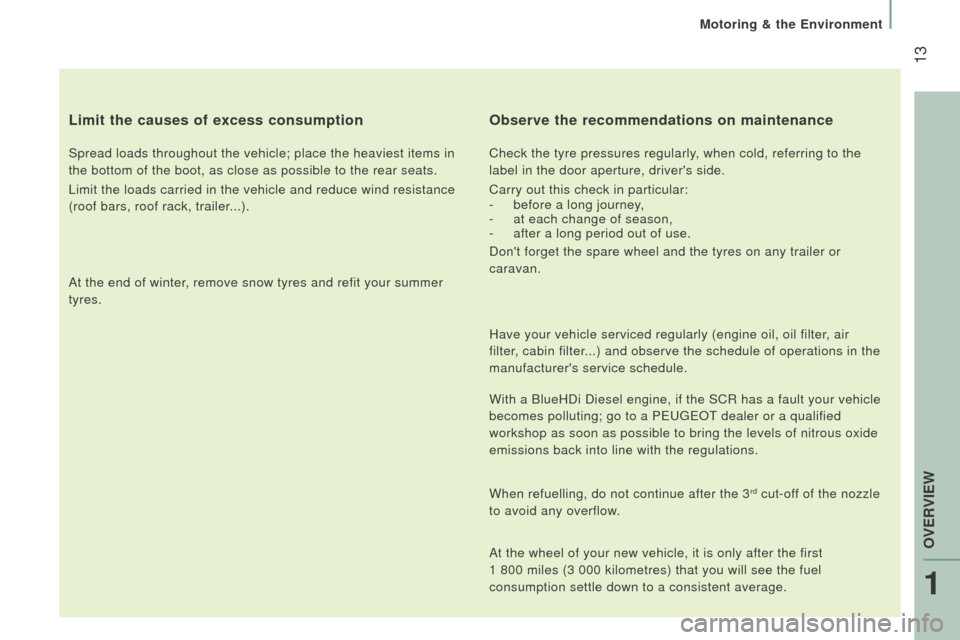
13
boxer_en_Chap01_Vue-ensemble_ed01-2015
Limit the causes of excess consumption
Spread loads throughout the vehicle; place the heaviest items in
the bottom of the boot, as close as possible to the rear seats.
Limit the loads carried in the vehicle and reduce wind resistance
(roof bars, roof rack, trailer...).
At the end of winter, remove snow tyres and refit your summer
tyres.
observe the recommendations on maintenance
Check the tyre pressures regularly, when cold, referring to the
label in the door aperture, driver's side.
Carry out this check in particular:
-
before a long journey
,
-
at each change of season,
-
after a long period out of use.
Don't forget the spare wheel and the tyres on any trailer or
caravan.
Have your vehicle serviced regularly (engine oil, oil filter, air
filter, cabin filter...) and observe the schedule of operations in the
manufacturer's service schedule.
With a BlueHDi Diesel engine, if the SCR has a fault your vehicle
becomes polluting; go to a P
euge O t
dealer or a qualified
workshop as soon as possible to bring the levels of nitrous oxide
emissions back into line with the regulations.
When refuelling, do not continue after the 3
rd cut-off of the nozzle
to avoid any overflow.
At the wheel of your new vehicle, it is only after the first
1
800
miles (3 000 kilometres) that you will see the fuel
consumption settle down to a consistent average.
1
OVeRVIeW
Motoring & the environment
Page 16 of 292
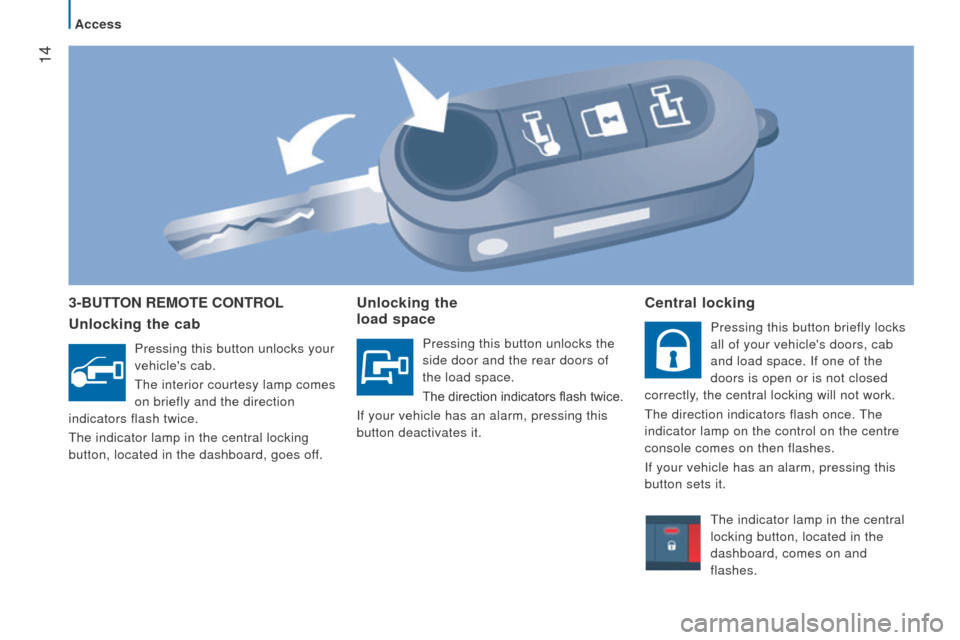
14
boxer_en_Chap02_Pret-a-Partir_ed01-2015
3-Button rEMotE controL
u nlocking the cab
Pressing this button unlocks your
vehicle's cab.
t
he interior courtesy lamp comes
on briefly and the direction
indicators flash twice.
t
he indicator lamp in the central locking
button, located in the dashboard, goes off.
unlocking the
load space
Pressing this button unlocks the
side door and the rear doors of
the load space.
The direction indicators flash twice.
If your vehicle has an alarm, pressing this
button deactivates it.
central locking
Pressing this button briefly locks
all of your vehicle's doors, cab
and load space. If one of the
doors is open or is not closed
correctly, the central locking will not work.
t
he direction indicators flash once.
t
he
indicator lamp on the control on the centre
console comes on then flashes.
If your vehicle has an alarm, pressing this
button sets it.
t
he indicator lamp in the central
locking button, located in the
dashboard, comes on and
flashes.
Access
Page 17 of 292
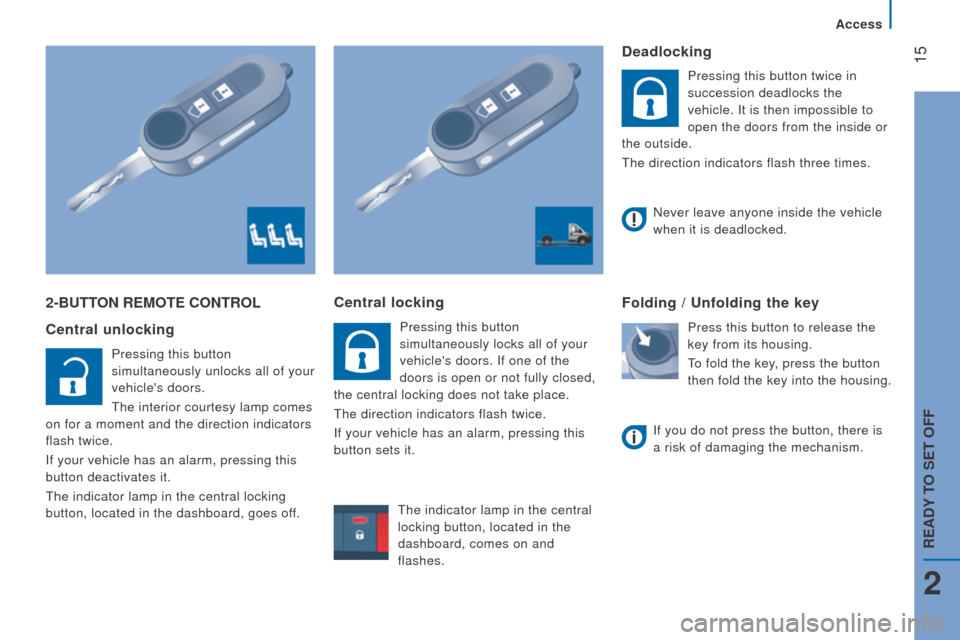
15
boxer_en_Chap02_Pret-a-Partir_ed01-2015
2-Button rEMotE controL
c entral unlocking
Pressing this button
simultaneously unlocks all of your
vehicle's doors.
t
he interior courtesy lamp comes
on for a moment and the direction indicators
flash twice.
If your vehicle has an alarm, pressing this
button deactivates it.
t
he indicator lamp in the central locking
button, located in the dashboard, goes off.
central locking
Pressing this button
simultaneously locks all of your
vehicle's doors. If one of the
doors is open or not fully closed,
the central locking does not take place.
t
he direction indicators flash twice.
If your vehicle has an alarm, pressing this
button sets it.
deadlocking
Pressing this button twice in
succession deadlocks the
vehicle. It is then impossible to
open the doors from the inside or
the outside.
t
he direction indicators flash three times.
Folding / unfolding the key
Press this button to release the
key from its housing.
to fold the key
, press the button
then fold the key into the housing.
Never leave anyone inside the vehicle
when it is deadlocked.
If you do not press the button, there is
a risk of damaging the mechanism.
t
he indicator lamp in the central
locking button, located in the
dashboard, comes on and
flashes.
2
Access
rEAdY to SEt oFF
Page 18 of 292
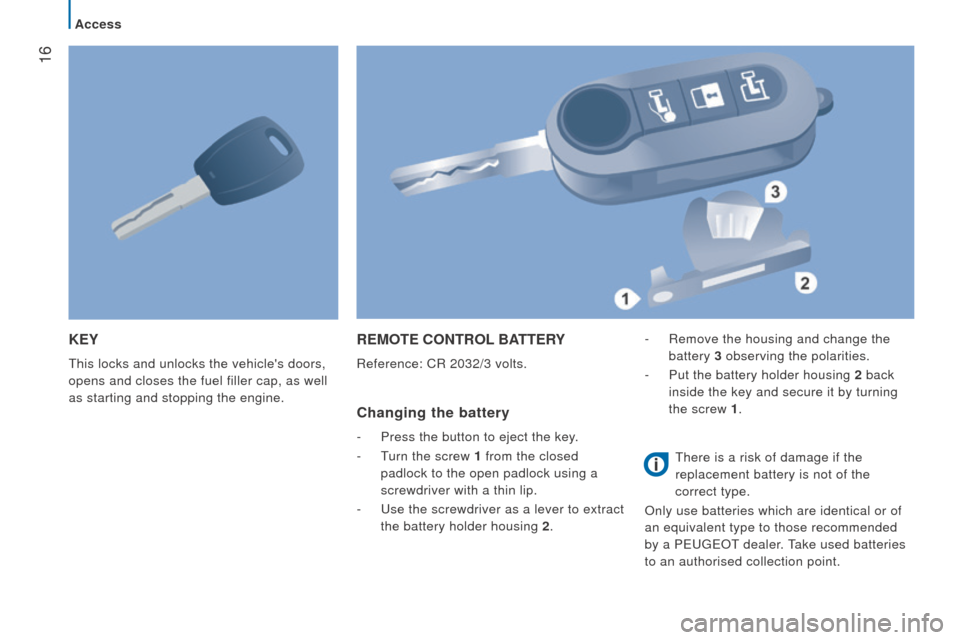
16
boxer_en_Chap02_Pret-a-Partir_ed01-2015
KEY
this locks and unlocks the vehicle's doors,
opens and closes the fuel filler cap, as well
as starting and stopping the engine.
rEMotE controL BAtt E rY
Reference: CR 2032/3 volts.
changing the battery
- Press the button to eject the key .
- t
urn the screw
1 from the closed
padlock to the open padlock using a
screwdriver with a thin lip.
-
u se the screwdriver as a lever to extract
the battery holder housing 2 .-
Remove the housing and change the
battery 3 observing the polarities.
-
Put the battery holder housing
2
back
inside the key and secure it by turning
the screw 1 .
t here is a risk of damage if the
replacement battery is not of the
correct type.
Only use batteries which are identical or of
an equivalent type to those recommended
by a P
euge O t
dealer
.
take used batteries
to an authorised collection point.
Access
Page 19 of 292
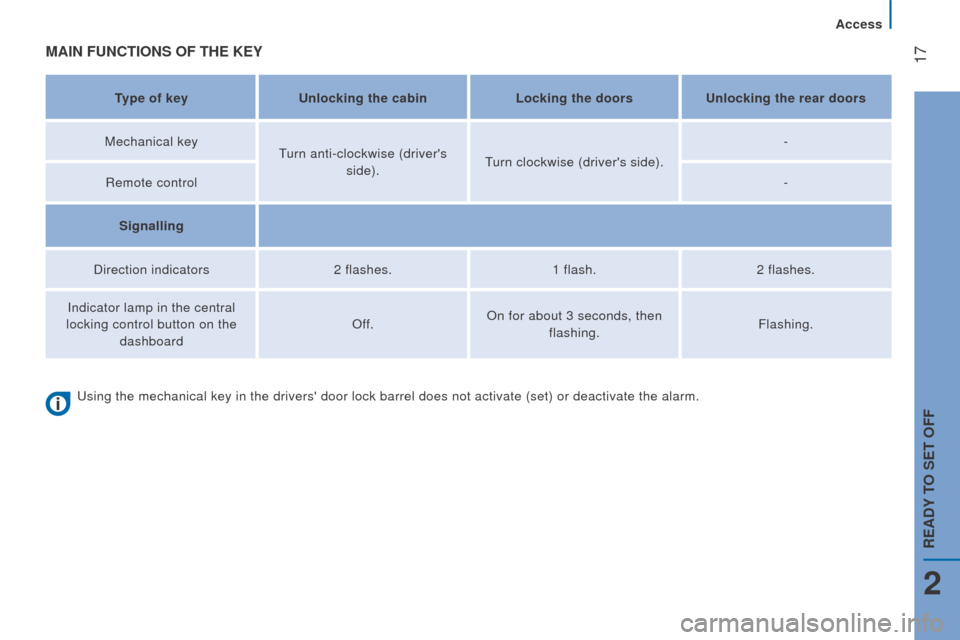
17
boxer_en_Chap02_Pret-a-Partir_ed01-2015
MAIn FunctIonS oF tHE KEY
type of keyunlocking the cabin Locking the doorsu nlocking the rear doors
Mechanical key
turn anti-clockwise (driver's
side).
turn clockwise (driver's side). -
Remote control -
Signalling
Direction indicators 2 flashes.1 flash.2 flashes.
Indicator lamp in the central
locking control button on the dashboard Off.
On for about 3 seconds, then
flashing. Flashing.
u
sing the mechanical key in the drivers' door lock barrel does not activa\
te (set) or deactivate the alarm.
2
Access
rEAdY to SEt oFF
Page 20 of 292
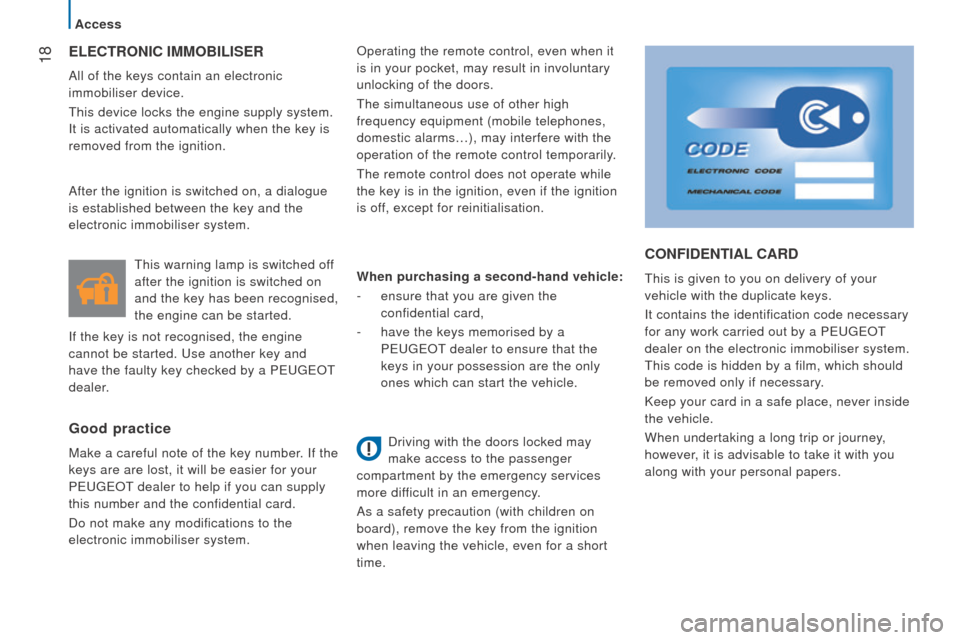
18
boxer_en_Chap02_Pret-a-Partir_ed01-2015
ELEctronIc IMMoBILISEr
All of the keys contain an electronic
immobiliser device.
t
his device locks the engine supply system.
It is activated automatically when the key is
removed from the ignition. Operating the remote control, even when it
is in your pocket, may result in involuntary
unlocking of the doors.
t
he simultaneous use of other high
frequency equipment (mobile telephones,
domestic alarms…), may interfere with the
operation of the remote control temporarily.
t
he remote control does not operate while
the key is in the ignition, even if the ignition
is off, except for reinitialisation.
Good practice
Make a careful note of the key number. If the
keys are are lost, it will be easier for your
P
euge O t
dealer to help if you can supply
this number and the confidential card.
Do not make any modifications to the
electronic immobiliser system.
t
his warning lamp is switched off
after the ignition is switched on
and the key has been recognised,
the engine can be started.
If the key is not recognised, the engine
cannot be started. u se another key and
have the faulty key checked by a P euge O t
dealer
.
After the ignition is switched on, a dialogue
is established between the key and the
electronic immobiliser system.
conFIdEntIAL cArd
this is given to you on delivery of your
vehicle with the duplicate keys.
It contains the identification code necessary
for any work carried out by a P
euge O t
dealer on the electronic immobiliser system.
t
his code is hidden by a film, which should
be removed only if necessary.
Keep your card in a safe place, never inside
the vehicle.
When undertaking a long trip or journey,
however, it is advisable to take it with you
along with your personal papers.
When purchasing a second-hand vehicle:
-
ensure that you are given the
confidential card,
-
have the keys memorised by a
P
euge
O
t
dealer to ensure that the
keys in your possession are the only
ones which can start the vehicle.
Driving with the doors locked may
make access to the passenger
compartment by the emergency services
more difficult in an emergency.
As a safety precaution (with children on
board), remove the key from the ignition
when leaving the vehicle, even for a short
time.
Access